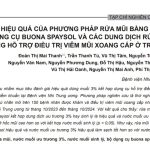
Hỏi Đáp cùng chuyên gia tư vấn BUONA
Hướng dẫn sử dụng chuyên mục hỏi đáp
Thông tin trong chuyên mục chỉ mang tính chất tham khảo, việc điều trị cần liên hệ với bác sỹ để có thông tin chính xác.
- Trước khi đặt câu hỏi mới, hãy sử dụng chức năng " Tìm câu hỏi" để tìm câu hỏi tương tự
- Sử dụng chức năng " Kiểu sắp xếp" để sắp xếp hiển thị câu hỏi theo thứ tự mong muốn
- Bấm vào nút " Đặt câu hỏi" để gửi câu hỏi.
- Việc bình luận, bình chọn sẽ giúp bạn tích điểm và được ưu tiên trả lời khi đặt câu hỏi
- Những câu hỏi, comment không phù hợp sẽ không được đăng hoặc bị xóa bởi ban Quản trị, nick comment có thể bị khiển trách hoặc xóa nick tùy theo mức độ nghiêm trọng của vi phạm.
Xin chào Buona,
Con trai tôi 2 tuổi, bé bị viêm mũi dị ứng từ bé. Hiện tại bé đã 2 tuổi nhưng thường xuyên bị viêm mũi dị ứng vào thời điểm giao mùa, hoặc mùa thu – đông. Bệnh ảnh hưởng nhiều đến khả năng hô hấp và phát triển của cháu. Vì vậy, tôi muốn sử dụng sản hẩm Nebial KIT để vệ sinh mũi cho bé hàng ngày, xin vui lòng tư vấn cách thức sử dụng?
3867 answers
Каталог вакансий – конечный пункт назначения для всех, кто ищет работу. Мы соединяем соискателей с ведущими работодателями, предлагая:
Доступ к обширной сети вакансий в режиме реального времени.
Удобный поисковый интерфейс с расширенными фильтрами.
курьер яндекс
Персонализированные рекомендации на основе ваших навыков и интересов.
Эксклюзивные партнерства с ведущими компаниями.
Бесплатные инструменты для создания и оптимизации вашего резюме.
The mysterious symbols found carved in Qatar’s desert
[url=https://rutube.ru/video/98e7f1cec0843c1d18fdb14bf1686d96/]красивый анальный секс[/url]
Some shoot out of the soft rock like reptiles bathing in the sun. Others are mysterious depressions resembling an ancient board game played all over the world. And a few are straight-up puzzling.
On a desolate and windswept corner of Qatar’s northeastern coast, among the sand dunes of the barren desert, lies Al Jassasiya, the Gulf country’s largest and most important rock art site.
Here, people centuries ago used a series of low-lying limestone outcrops as a canvas on which they carved symbols, motifs and objects that they observed in their environment.
Overall, archaeologists have found a total of some 900 rock carvings, or “petroglyphs,” at Al Jassasiya. They are mostly enigmatic cup marks arranged in various patterns, including rows and rosettes, but also eye-catching representations of sailing ships, usually seen from above but also depicted in linear profile, among other symbols and signs.
“Although rock art is common in the Arabian Peninsula, some of the carvings in Al Jassasiya are unique and cannot be found anywhere else,” Ferhan Sakal, head of excavation and site management at Qatar Museums, told CNN, referring to the petroglyphs of ships seen from a bird’s-eye view.
“These carvings represent a high degree of creativity and observation skills [on the part of] the artists who made them,” he said. “Also [of] abstract thinking, as they were not able to see the dhow (a traditional ship) from above.”
A giant meteorite boiled the oceans 3.2 billion years ago. Scientists say it was a ‘fertilizer bomb’ for life
[url=https://ren.tv/news/kriminal/1125239-afera-na-15-mlrd-kak-rabota-finansovaia-piramida-laif-iz-gud]порно групповое жесток[/url]
A massive space rock, estimated to be the size of four Mount Everests, slammed into Earth more than 3 billion years ago — and the impact could have been unexpectedly beneficial for the earliest forms of life on our planet, according to new research.
Typically, when a large space rock crashes into Earth, the impacts are associated with catastrophic devastation, as in the case of the demise of the dinosaurs 66 million years ago, when a roughly 6.2-mile-wide (10-kilometer) asteroid crashed off the coast of the Yucatan Peninsula in what’s now Mexico.
But Earth was young and a very different place when the S2 meteorite, estimated to have 50 to 200 times more mass than the dinosaur extinction-triggering Chicxulub asteroid, collided with the planet 3.26 billion years ago, according to Nadja Drabon, assistant professor of Earth and planetary sciences at Harvard University. She is also lead author of a new study describing the S2 impact and what followed in its aftermath that published Monday in the journal Proceedings of the National Academy of Sciences.
“No complex life had formed yet, and only single-celled life was present in the form of bacteria and archaea,” Drabon wrote in an email. “The oceans likely contained some life, but not as much as today in part due to a lack of nutrients. Some people even describe the Archean oceans as ‘biological deserts.’ The Archean Earth was a water world with few islands sticking out. It would have been a curious sight, as the oceans were probably green in color from iron-rich deep waters.”
When the S2 meteorite hit, global chaos ensued — but the impact also stirred up ingredients that might have enriched bacterial life, Drabon said. The new findings could change the way scientists understand how Earth and its fledgling life responded to bombardment from space rocks not long after the planet formed.
Trạng thái câu hỏi







